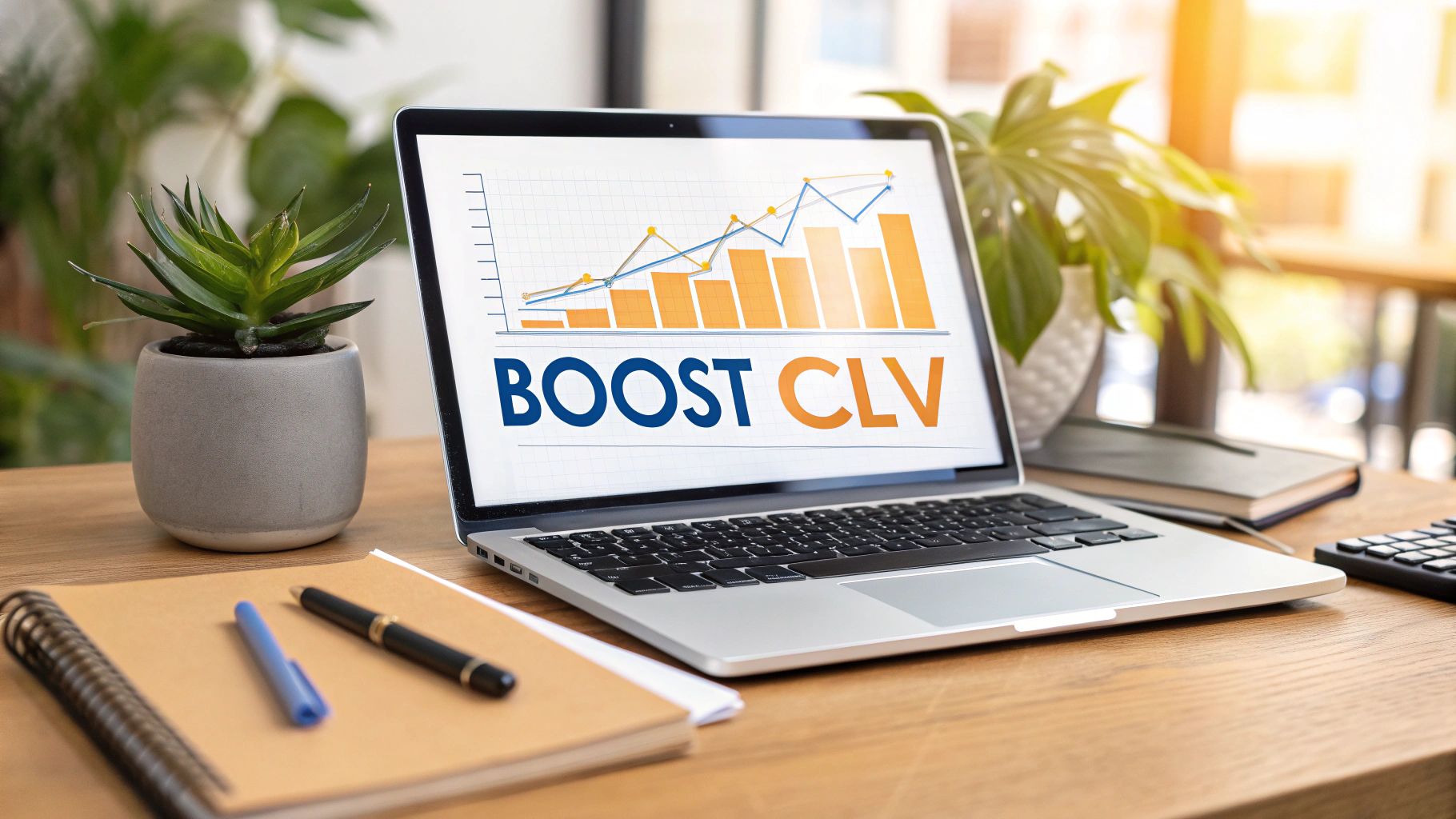Chasing new leads is a grind. The real secret to building a powerhouse digital business is a strategic shift—moving away from the constant hunt for new customers and toward nurturing the ones you already have. This isn't just a feel-good strategy; focusing on retention and loyalty is the most reliable path to building long-term, predictable revenue.
When you truly understand what keeps your customers coming back, you're not just boosting a metric. You're building a more stable, profitable company.
Why Customer Lifetime Value Is Your Most Important Metric
Let’s be blunt: the old playbook of "more new customers, always" is a losing game. The cost to get someone to click that "buy" button for the first time is climbing at an insane rate. Relying only on acquisition is like trying to fill a leaky bucket—you're spending more and more just to stay afloat.
This is where Customer Lifetime Value (CLV) completely changes the conversation. It's not just another number on your dashboard; it's a fundamental shift in how you think about your business. You stop celebrating just the first sale and start prioritizing the entire relationship.
The Financial Case for a CLV-Focused Approach
The numbers don't lie. Over the last eight years, the cost of acquiring new customers has shot up by a staggering 222%. That stat alone makes focusing on your existing customer base a financial necessity, not just a nice-to-have.
Here’s the kicker: even a tiny 5% boost in customer retention can crank up profitability by over 25%. In some industries, that same small effort can nearly double profits, increasing them by as much as 95%. That's the massive impact of nurturing the relationships you've already built. You can dig into more of these customer value statistics and their impact to see just how powerful this is.
It all points to one core truth: your existing customers are your most valuable asset. They’ve already chosen you once. If you give them a good reason, they're far more likely to do it again.
Focusing on CLV is about playing the long game. It's the difference between a one-night-stand sale and a long-term, profitable partnership. The initial transaction is just the beginning of the story, not the end.
Moving Beyond Short-Term Wins
When you're obsessed with acquisition, you end up making short-sighted decisions. Think deep, unsustainable discounts just to get a sale over the line. But when you start thinking in terms of CLV, your strategies naturally shift toward building lasting value.
Here’s what that looks like in the real world:
- Smarter Resource Allocation: You can confidently spend more to keep your high-value customers happy because you know the long-term payoff is huge.
- Improved Product Development: Feedback from loyal customers is absolute gold. It tells you exactly how to refine your products to better serve your best audience.
- Sustainable Growth: Your revenue becomes more predictable. Instead of riding the volatile rollercoaster of lead flow, you build a stable foundation of repeat business.
To really drive this point home, let's look at how these two mindsets stack up against each other.
CLV-Focused vs. Acquisition-Focused Marketing
| Aspect | Acquisition-Focused Strategy | CLV-Focused Strategy |
|---|---|---|
| Primary Goal | Maximize the number of new customers | Maximize the long-term value of each customer |
| Key Metrics | Cost Per Acquisition (CPA), Conversion Rate | Customer Lifetime Value (CLV), Retention Rate, Churn Rate |
| Marketing Spend | Heavily weighted toward top-of-funnel ads and lead gen | Balanced spend across acquisition, retention, and loyalty programs |
| Communication | Transaction-focused, often generic | Personalized, relationship-driven, and ongoing |
| Product Feedback | Gathers feedback primarily from new users | Values and actively seeks feedback from long-term, loyal customers |
| Success Horizon | Short-term (did we hit this month's sales target?) | Long-term (are we building a sustainable revenue stream?) |
Switching to a CLV-first mindset doesn't mean you stop trying to get new customers. It just means you start treating the customers you win with the attention they deserve, turning one-time buyers into lifelong fans.
By embracing a CLV-focused mindset, you're doing more than just improving a metric; you're fundamentally strengthening the financial health and long-term stability of your entire business. In a competitive market, it's the most powerful lever you have for sustainable growth.
How to Measure and Understand Your CLV
You can't improve what you don't measure. Before you can start boosting your customer lifetime value, you need a clear picture of where it stands right now. Thankfully, you don't need a data science degree to get a handle on CLV. It's all about breaking it down into a few core numbers you probably already have.
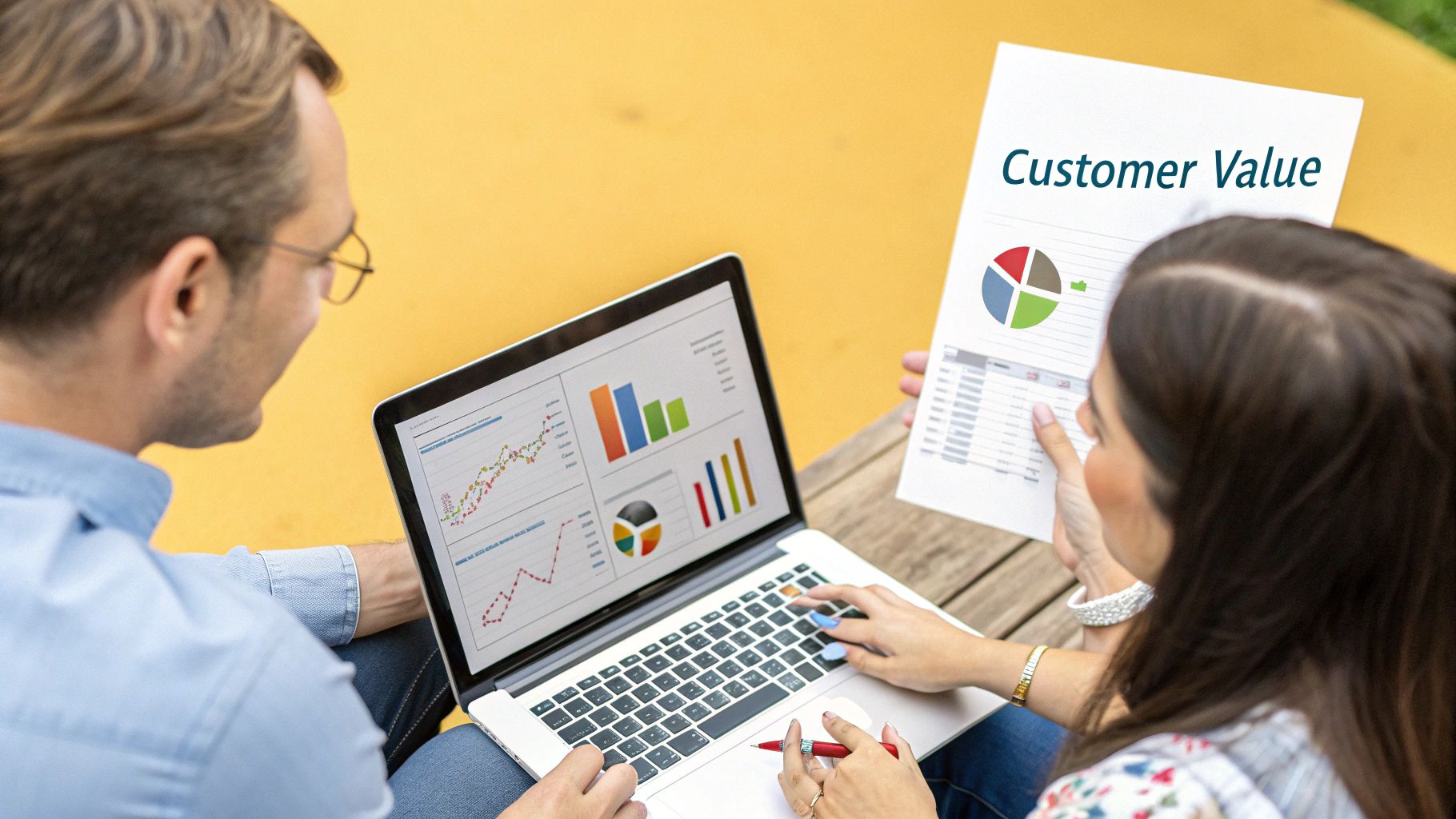
This image breaks down the classic CLV formula. By understanding each piece, you can see exactly which levers to pull to grow the lifetime value of your customers.
Breaking Down the Core CLV Components
Calculating a basic, historical CLV is surprisingly straightforward. It just comes down to three key metrics that, when combined, tell the story of your customer relationships over time. Most e-commerce platforms like Shopify or CRM systems like HubSpot are already tracking this data for you.
You'll just need to pull these three numbers:
- Average Purchase Value (APV): This is just the average amount a customer spends per transaction. Find it by dividing your total revenue over a set period (like a year) by the total number of orders in that same timeframe.
- Purchase Frequency (PF): This one tells you how often the average customer buys from you. You can calculate it by dividing the total number of orders by the number of unique customers during that same period.
- Customer Lifespan (CL): This is your best guess for how long a customer will stick around and keep buying. A simple way to estimate this is to use the average time a customer stays active before they go quiet or churn.
Once you have those figures, the math is simple: (APV x PF) x CL = CLV. This gives you a powerful baseline for what a customer is actually worth to your business over their entire relationship with you.
Historical vs. Predictive CLV Models
The calculation we just walked through gives you a Historical CLV. It’s based on past data, which makes it perfect for getting a quick, reliable snapshot of your performance. It tells you what has happened.
But for more forward-looking strategy, many businesses turn to Predictive CLV. These models use more advanced algorithms and sometimes machine learning to forecast a customer's future spending habits. While they're definitely more complex, predictive models are gold for identifying high-potential new customers early on.
For most businesses just getting started, though, mastering historical CLV is the perfect first step. It gives you plenty of actionable insights without needing a bunch of complicated tools.
Turning Data into Action Through Segmentation
Okay, so calculating a single, business-wide CLV is a great start. But the real magic happens when you start segmenting your customers. Not all customers are created equal, and understanding those differences is the key to spending your marketing budget wisely.
Segmentation is what lets you move from a one-size-fits-all approach to a targeted strategy. You can invest your resources where they'll have the biggest impact—on your most valuable customer relationships.
Start by creating a few simple value tiers based on CLV:
- High-Value Customers (Your VIPs): These are the top 20% of your customers who likely drive a huge chunk of your revenue. They deserve special treatment.
- Mid-Value Customers (Your Core): This group is consistent but has the potential to spend more. They just need the right encouragement.
- Low-Value Customers (At-Risk or Occasional): These customers buy infrequently and might need a little nudge to prevent them from churning for good.
Once you've segmented your audience, you can tailor your marketing. Your VIPs might get exclusive perks and early access, while your low-value customers could receive a special offer to spark their next purchase. This targeted approach is way more effective and ties directly into boosting your marketing return. If you want to dig deeper into that, our guide explains in detail how to measure ROI on these kinds of initiatives.
Strategies That Actually Boost Retention and Loyalty
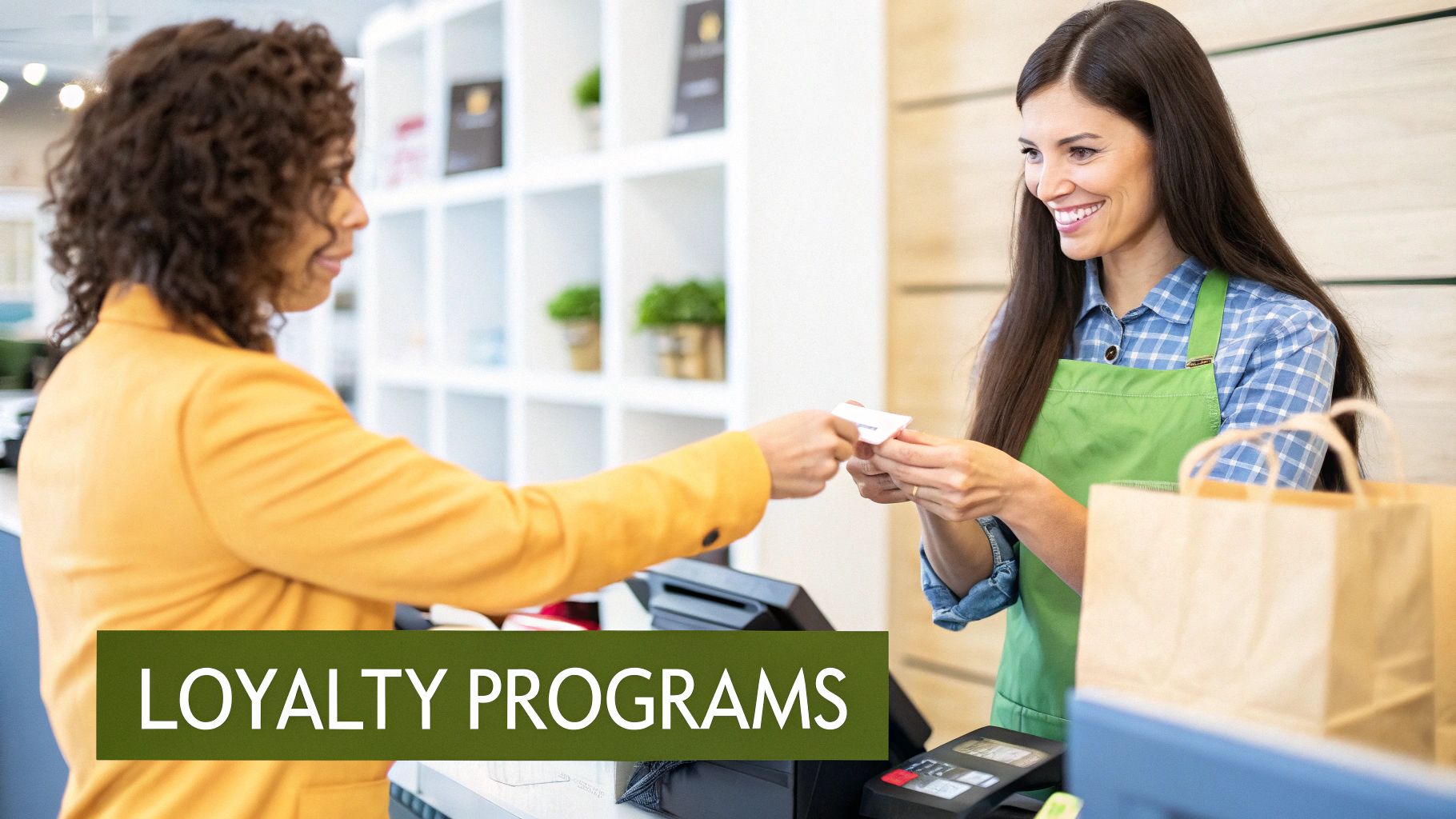
Knowing your CLV is one thing. Actually increasing it is where the real work begins.
Boosting customer lifetime value isn't about some magic bullet. It’s about building a system of experiences that consistently reinforces a customer's decision to choose you. This is how you transform one-time buyers into genuine, loyal advocates for your brand.
The core of this whole effort is crafting an exceptional customer experience. It starts the second someone signs up or makes their first purchase and carries through every single interaction they have with you. This isn’t just about being nice; it's a direct driver of profitability. A landmark Forrester study found that businesses focused on customer experience generate 60% higher profits than those that don't. That makes a pretty clear case for investing in every touchpoint.
Craft a Flawless Onboarding and Support Experience
Your first impression sets the tone for the entire relationship. A clunky, confusing onboarding process is a fast track to churn. The goal is to make new customers feel smart, confident, and immediately see the value in what they just bought.
We cover this in-depth in our guide on https://upnorthmedia.co/blog/how-to-improve-customer-experience, but the basics are essential.
Think beyond a simple "welcome" email. A great onboarding sequence could include:
- A quick-start guide: A short, digestible video or checklist that helps users get their first "win" with your product right away.
- Proactive check-ins: An automated email a few days later asking if they have any questions or need a hand.
- Easy access to help: Make your support channels—live chat, a knowledge base, a community forum—obvious and easy to find.
Proactive support is the other side of this coin. Instead of just reacting to problems, anticipate them. If a customer's subscription is about to expire, send a friendly reminder. If you notice a user is stuck on a particular feature, reach out with a helpful tutorial. This level of care shows you're paying attention and builds incredible goodwill.
Build Loyalty Programs That Genuinely Reward
Loyalty programs are a classic strategy for a reason—they work. But the best programs feel less like a transactional discount scheme and more like a genuine appreciation for your best customers. The key is offering rewards that your audience actually values.
For example, a cosmetics brand might offer points that can be redeemed for free products, early access to new collections, or exclusive beauty tutorials. A SaaS company, on the other hand, could offer account credits, a free month of service, or access to premium features for loyal subscribers.
The best loyalty programs create a sense of belonging. They make your best customers feel like insiders who get special treatment, reinforcing their connection to your brand beyond just the products they buy.
Your program has to be simple to understand and easy to use. If customers have to jump through hoops to redeem their rewards, they'll lose interest fast.
Use Strategic Communication to Stay Relevant
Staying top-of-mind is crucial, but it has to be done with purpose. Bombarding customers with generic promotions is a surefire way to get them to hit "unsubscribe." Your communication should be personalized, relevant, and consistently valuable.
Here’s how to make your communication strategy work for you:
- Segment Your Email Lists: Don't send the same message to everyone. Group your customers based on their purchase history, engagement level, or CLV segment. A high-value customer should get different offers than a brand-new subscriber.
- Provide Value Beyond Promotions: Share useful content that helps your customers get more out of your product or industry. Think helpful blog posts, expert tips, or case studies that showcase success stories.
- Personalize Your Offers: Use the data you have to create offers that feel tailor-made. A Clutch study found that 71% of consumers prefer personalized offers. If a customer frequently buys a specific product, let them know when it's back in stock or on sale.
Ultimately, these tactics are all connected. A great support experience makes a customer more likely to join your loyalty program, and personalized communication keeps them engaged between purchases. For a deeper dive, explore these key strategies for increasing customer lifetime value. By focusing on these core areas, you create a powerful cycle of retention that translates directly into higher CLV and a healthier, more predictable business.
Using Data to Personalize and Upsell Effectively
Getting each customer to spend more over time is one of the most direct ways to boost your CLV. This isn’t about hitting them with aggressive sales tactics. It’s about using the data you already have to make your customers feel seen and understood.
When you nail personalization, upselling and cross-selling just become a natural, helpful part of the conversation.
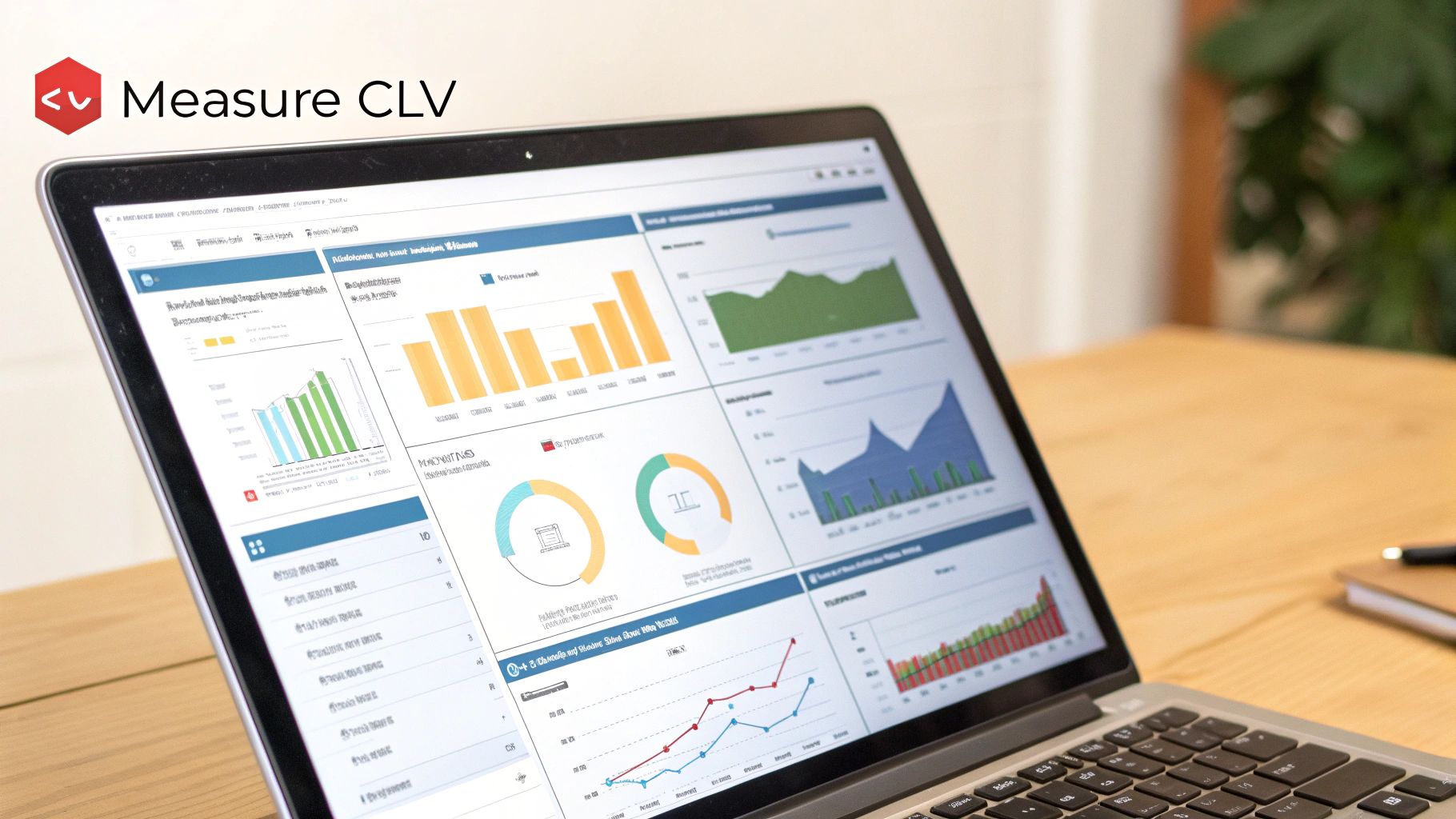
The goal is to stop thinking, "How can we sell more?" and start asking, "How can we solve their next problem before they even ask?" This is how you build real trust and, in turn, drive up that lifetime value. It shows you’re paying attention to their needs, not just their wallet.
Unlocking Insights from Customer Behavior
The most powerful tool you have for smart upselling is the data your customers are already giving you. Their purchase history and browsing behavior are a goldmine. This data tells you exactly what they value, what they’re curious about, and where they might need a little more help.
Start by looking for patterns. Does someone consistently buy products from a specific category? Have they repeatedly checked out a premium product page but never pulled the trigger? These actions are basically neon signs pointing to their interests.
For instance, a customer who bought entry-level running shoes and now regularly views your high-performance gear is the perfect candidate for a targeted offer. An email explaining the benefits of the advanced cushioning in those premium shoes feels like genuine advice, not a pushy sales pitch. In fact, a recent survey found that 53.9% of customers want brands to recommend products based on their past purchases—it's an expectation now.
Implementing Smart Recommendation Systems
You don’t need a complicated AI to start offering tailored product recommendations. Simple, rule-based systems can be incredibly effective right out of the gate. Just by analyzing what customers tend to purchase together, you can create powerful cross-sell opportunities that genuinely improve their experience.
Here are a few practical ways to do this:
- "Frequently Bought Together" prompts: On a product page or at checkout, show items that other customers often buy with the main product. Someone buying a tent is probably going to need a sleeping bag and a lantern. Simple, but it works.
- Post-purchase email flows: A week after a customer buys a new coffee machine, send them an email showcasing your best-selling espresso beans or a high-quality milk frother. It’s timely and relevant.
- In-app suggestions: If you run a SaaS business and a user is constantly bumping up against their data limit, a timely, automated prompt to upgrade their plan is a helpful upsell that solves an immediate headache for them.
These small nudges are effective because they’re contextually relevant. The suggestions feel like a natural part of the shopping journey, not an interruption.
The best upselling feels like a concierge service. You're anticipating the customer's next need and presenting a solution at the exact moment they're most likely to need it. This transforms the transaction into a value-added interaction.
Using Segmentation for Targeted Offers
Once you start analyzing behavior, you can segment your customers into distinct groups and craft offers that speak directly to what they need. This goes way beyond basic demographics and dives into how people actually interact with your brand.
Imagine you run a SaaS company. You could create segments like these:
- "Power Users": This group lives in your advanced features daily. They are prime candidates for an upsell to a "Pro" plan that offers even more capabilities or early access to new beta features.
- "Feature Explorers": These users have tried a few different tools but haven't settled into a solid routine. They might benefit from an educational email campaign that highlights a specific feature they haven’t used yet, maybe with a small discount to upgrade.
- "Basic Users": This segment sticks to the core functionality. Instead of pushing a huge upgrade, a better approach might be a cross-sell offer for a complementary tool that solves a related problem.
This kind of targeted approach ensures your marketing messages are relevant and valuable. When you align your offers with a customer's actual usage and demonstrated needs, you make the path to a higher-value plan a logical and welcome next step. This focus on being helpful is what turns a one-off transaction into a long-term, profitable relationship.
Finding and Nurturing Your High-Value Customers
Let's be honest: not all customers are created equal. The classic 80/20 rule absolutely applies when you're trying to boost customer lifetime value. A small slice of your customer base is likely driving a huge chunk of your revenue. Your job is to figure out who these people are and treat them like the VIPs they are.
This isn't about giving new customers the cold shoulder. It's about being smart with your resources and putting them where they'll generate the biggest return. By zeroing in on your most valuable relationships, you build a rock-solid, profitable core for your business. You also turn happy buyers into your best brand advocates.
Identifying and Segmenting by Customer Value
First things first, you need to get into your data and sort your customers into clear value tiers. This is how you move past the one-size-fits-all marketing trap and start tailoring your efforts to how different groups actually behave. It's a critical step before you even think about building out detailed user profiles. If you need a refresher on that, our guide on how to create buyer personas is a great place to start.
A simple but super effective way to segment is to create three main tiers based on their CLV or just their overall spending habits:
- VIP Customers: This is your top shelf. They buy often, spend a lot, and are genuinely engaged with your brand.
- Core Customers: These are your steady, reliable buyers. They might not have the spending power of your VIPs, but they're the backbone of your day-to-day revenue.
- At-Risk Customers: This group is made up of infrequent buyers or folks who haven't purchased in a while. They're on the verge of churning if you don't do something to re-engage them.
The chart below really drives this point home, showing how key metrics can vary wildly across different customer segments.
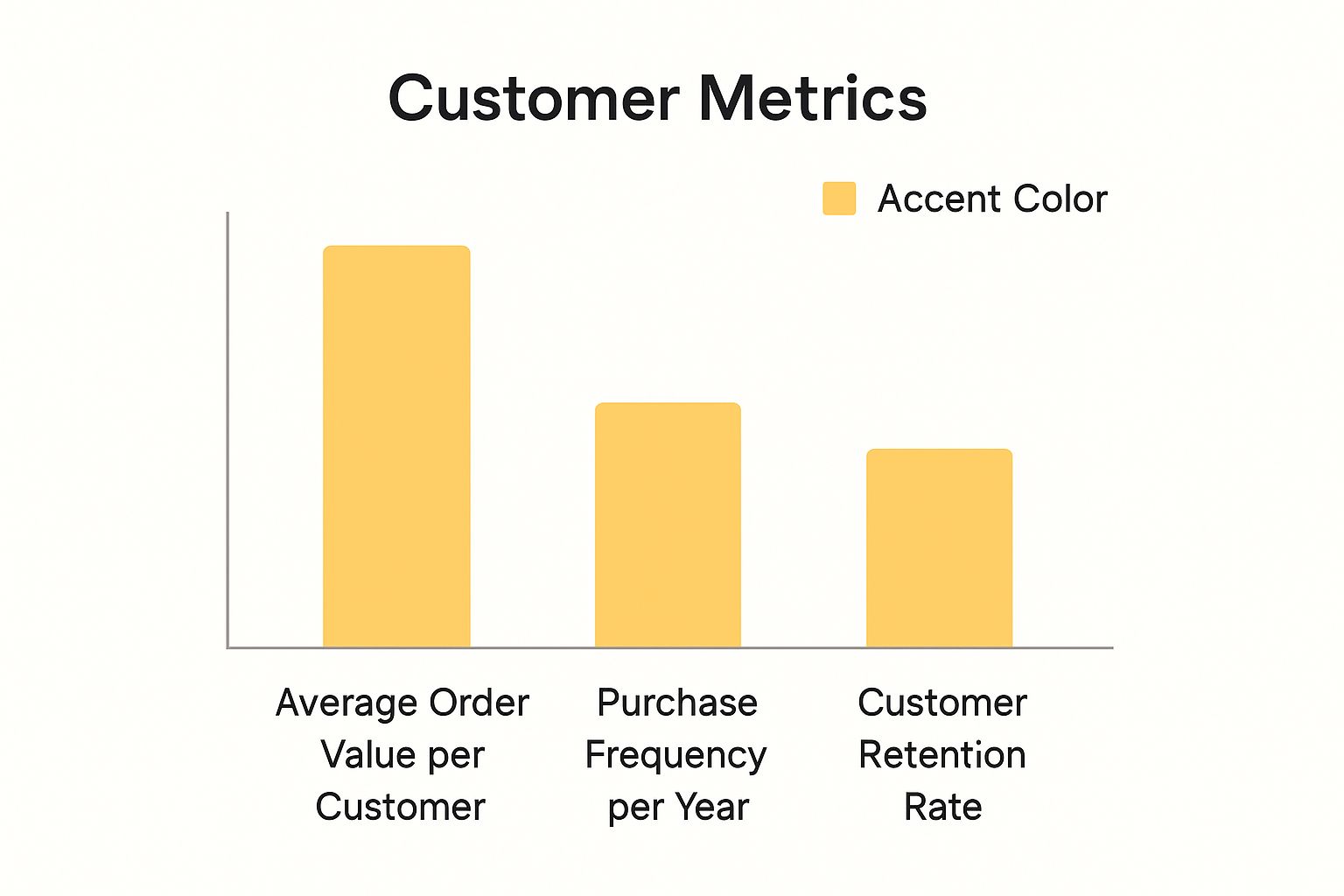
As you can see, high-value customers don't just spend more per order—they buy more often and stick around longer. This data is the proof in the pudding for why targeted nurturing is so important.
Tailored Nurturing Strategies for Each Segment
Once you've got your segments sorted, you can stop shouting the same message at everyone and start having real conversations. Each group needs a different touch to maximize their potential and strengthen their connection to your brand.
For your VIP Customers, it’s all about appreciation and exclusivity. These are not the people you send a generic 10% off coupon to. Think bigger. Focus on tactics that make them feel like true insiders.
To give you a better idea, here’s a quick breakdown of how you might approach nurturing each segment.
Nurturing Strategies by Customer Value Segment
| Customer Segment | Primary Goal | Example Tactics |
|---|---|---|
| VIP Customers | Appreciation & Exclusivity | Early access to new products, a dedicated support line, or sending an unexpected gift or handwritten note. |
| Core Customers | Increase Frequency & Value | Targeted promotions on related products, a loyalty points system, or sending educational content to help them get more from their purchases. |
| At-Risk Customers | Reactivation | A "we miss you" email campaign with a compelling discount, a survey asking for feedback, or showcasing new features they might not know about. |
This segmented approach isn't just theory; the data backs it up. For instance, app users tend to be some of the most engaged customers, purchasing 33% more often and having a 3 to 5 times higher lifetime value. It’s a perfect example of how focusing on your most dedicated channels pays off in a big way.
By applying these tailored strategies, you build a more resilient customer base where every single segment is being nurtured in the way that makes the most sense for them.
Common Questions About Increasing CLV
Even with a solid plan, focusing on customer lifetime value can bring up some real-world questions. It's one thing to get the theory, but it's another to actually put it into practice. Let’s tackle some of the most common hurdles we see businesses hit when they start making CLV a priority.
Think of this as your field guide for those "yeah, but what about..." moments. We're laying out straightforward answers to the tricky parts so you can move forward with confidence.
How Long Does It Take To See a Real Impact on CLV?
This is the big one, and the honest-to-goodness answer is: it depends. You’re not going to double your CLV overnight. Growing customer lifetime value is all about building relationships for the long haul, not chasing quick, temporary spikes.
You can definitely get some quick wins. A simple post-purchase upsell flow, for instance, might bump up your Average Purchase Value in just a few weeks. That feels great, but the real, sustainable growth in CLV comes from the slow-burn efforts that need time to pay off.
- Loyalty Programs: You're probably looking at 6-12 months before you can spot a clear, undeniable trend of members buying more often.
- Improved Onboarding: The payoff here is all about long-term retention. You’ll see a dip in first-month churn pretty fast, but the true value stacks up over the entire time a customer stays with you.
The trick is to keep an eye on leading indicators. Don’t just stare at the final CLV number, waiting for it to jump. Track things like your repeat purchase rate, customer satisfaction scores, and churn rate. These metrics will tell you if you're on the right path long before the main CLV figure makes a dramatic move.
What’s the Best First Step for a Small Business?
If you're a small business owner, the idea of a massive CLV strategy can feel like a lot to take on. The best place to start? It's simple: deliver absolutely exceptional customer support.
Before you pour money into fancy analytics or a complex loyalty program, just make sure every single customer interaction is a good one. This is a low-cost, incredibly high-impact strategy that sets the foundation for everything else you'll do. Customers who feel taken care of are way more likely to stick around and buy from you again.
For a small business, your competitive edge isn't a huge marketing budget—it's your ability to build genuine human relationships. Start right there. The value will absolutely follow.
Once you’ve got your support dialed in, the next move is to just listen. Set up a simple way to get customer feedback, like an automated survey after a purchase. You'll get a goldmine of information on what to fix next, all without breaking the bank.
How Much Data Do I Actually Need for This to Work?
You really don't need a sprawling data warehouse to get going. If you're running an e-commerce store or using a CRM, you almost certainly have the essential data points to calculate a basic, historical CLV right now.
You just need to be able to answer three questions:
- How much does an average customer spend each time they buy?
- How many times do they typically buy from you in a year?
- How long does a customer usually stick with your business?
That's really it. Sure, more detailed data on things like browsing behavior or support ticket history is fantastic for advanced personalization down the road, but it's not a requirement to start. Work with what you have. The insights from a simple CLV calculation are more than enough to help you make smarter decisions today about where to put your marketing and retention efforts.
As you grow, you can layer in more sophisticated analysis. Just don't let the hunt for perfect data get in the way of taking action.
Ready to turn these strategies into measurable growth? The team at Up North Media specializes in data-driven SEO and custom web solutions that help businesses like yours build lasting customer relationships and boost revenue. Let’s talk about how we can elevate your digital strategy. Learn more at upnorthmedia.co.
